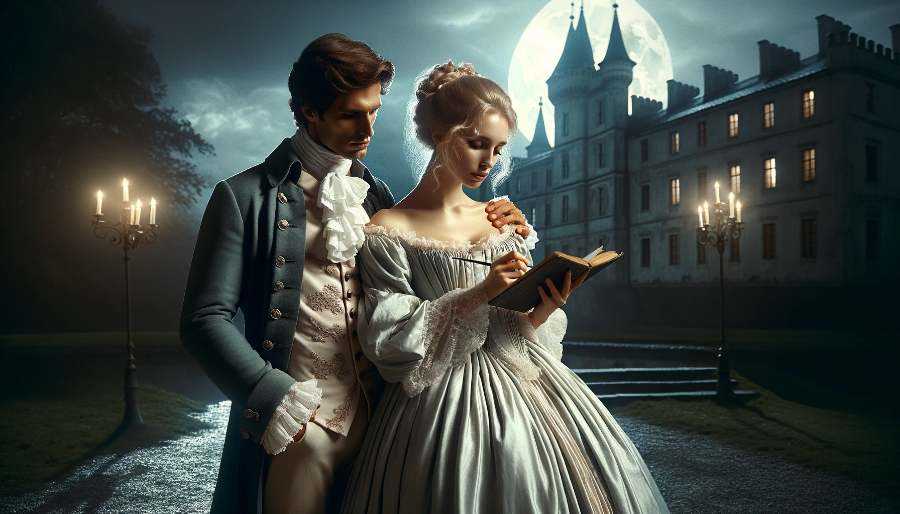How to Write a Romance Novel People Will Love
This page includes a step-by-step guide on how to write a romance novel. For more writing tips and ideas, be sure to join our free email group.
What you need to write romance:
- a bar of good chocolate
- a beach vacation
- a gorgeous stranger ready to be your muse...
Okay, you don't really need any of those things, but if you can finagle them—why not?
What you DO need:
- two characters who were meant to end up together.
- crackling chemistry between those characters.
- a problem or obstacle in the way of the characters' relationship—because, otherwise, the couple would jump straight to the happy ending, and there wouldn't be much of a story! Example: one of the characters is engaged to marry someone else.
- a reason for the characters to stick around each other long enough to overcome the obstacle to their relationship. Example: They are coworkers assigned to collaborate on an important project.
- a happy or optimistic ending—"Happily Ever After ("HEA"), or at least Happy For Now ("HFN").
Read on for advice on how to write a romance novel that readers—and editors—will fall head-over-heels in love with.
Skip to section:

Romance Subgenres
The first step to writing a successful romance novel is market research. Yes, that means pouring a glass of wine or a mug of hot chocolate, curling up on your sofa, and reading lots and lots of romance novels. It's a tough job, but somebody's got to do it.
Tip: Market research may be more productive if you're receiving a foot massage while you do it. You might want to mention that to your gorgeous muse.
There are many different subgenres, or categories, of romance novels; including:
- Contemporary romance
- Historical romance
- Romantic suspense
- Paranormal romance (e.g., vampires, werewolves, etc.)
- Fantasy romance (or "Romantasy")
- Science fiction romance
- Inspirational romance (religious themes)
- Medical romance (set in hospitals or other medical settings)
- Regency romance
- Gothic romance (likely to include mysterious events happening in spooky settings like a crumbling old mansion)
Once you've chosen a subgenre for your own novel, you'll want to read a lot in that subgenre and get to know what its readers expect. Then you can write a book that satisfies those expectations, while also adding your own fresh twist.
To get ideas of the kinds of romance novels currently being published, browse the romance publishers' websites such as Harlequin.com
Harlequin also posts guidelines for authors. You can use these guidelines to get story ideas and to learn more about what one publisher is looking for.
If you write a book that meets the guidelines, you can then submit it to Harlequin!
How to Write a Romance Novel in 5 Steps

1) Create two characters who will fall in love
You want to create a moving, emotional, satisfying experience for readers. The secret is to create characters your readers will identify with and fall in love with themselves.
Your characters need to come alive on the page. They should be like real people, with desires, fears, strengths, and weaknesses.
And there should be powerful chemistry between the couple. More on that soon.
Think about what each character wants, both in love and in that rest of their life, and what internal or external factors are holding them back. This will also give you ideas for your story plot!
Here's a character profile questionnaire to help you imagine your main characters.
- Name:
- Age:
- Profession:
- Physical appearance:
- Hobbies:
- Positive traits:
- Negative traits:
- Relationship status at the beginning of the story:
- Describe character's current or last relationship:
- What do they look for in a romantic partner?
- What do they really need in a romantic partner (if different from above)?
- Kind of person they're attracted to:
- Things that turn them off:
- How could they meet the main love interest in the story?
- What obstacles could be in the way of a happy ending with the main love interest?
- What's something that might keep them in touch with the main love interest, in spite of obstacles?
Click here to get a detailed character profiling questionnaire.
2) Plan your story conflict.
What is the main problem standing between your characters and their Happily Ever After? This might be an external problem (for example, if a character's family forbids the relationship), or it might be an internal one (for example, your character was hurt in a past relationship and now is afraid to be vulnerable again).
Click here for romance story ideas.

3) Map out some scenes
The following questions will give you ideas:
- How will your couple first meet?
- When will they first feel attracted to each other?
- How will your story conflict start?
- What will be the most intense moment of the conflict?
- What will be the turning point that will lead to your happy or hopeful ending?
You can make a list of scene ideas, describing each scene in a few words; for example:
- J. and L. first meeting at company holiday party.
- J. and L. are forced to share an office. L. is rude about it.
You might find it helpful to write each scene idea on a separate note card. Then you can play with the order of the cards, adding new scenes to fill in gaps and removing scenes that don't seem to fit.

4) Start writing!
Daydream a scene from your story, letting it play out in your imagination, and then capture that daydream on the page, including dialogue, action, descriptive details...
(Jokes aside, daydreaming is an actual part of the job. You want to create a thrilling romantic daydream for readers. The best way to start is by enjoying some fabulous daydreams yourself.)
During your first draft, don't worry about finding the perfect words or crafting perfect sentences. If you start editing yourself while you write, it makes it harder to daydream. You'll fix everything later, during the revision stage.
5) Revise
Once you've finished a rough draft, you can go back and improve it. Tip: Eating chocolate helps with the revision process, or at least makes it more fun.
First, read your draft through from start to finish as if you were an ordinary reader. What are your first impressions?
It's a good idea to start by revising big-picture issues in your manuscript, and then work your way down to sentence-level editing.
Do the characters come to life? Do you feel the chemistry between them? Do you feel gripped by the story? Is there any places that feel too slow, or scenes that need more fleshing out?
Click here to get a free revision checklist.
How to create sizzling chemistry on the page

Instead of just saying that characters are attracted to each other, find ways to show it; e.g., lingering looks, teasing banter, small gestures. Maybe your character gets nervous around their future mate, or maybe they start making excuses to drive past the other person's house. Maybe an accidental brush of hands leaves your character's skin tingling...
Here are some specific tools for dialing the temperature up...
1) Commonalities.
You can give your two main characters something important in common; for example, similar childhood struggles, or a shared passion for music. This can provide opportunities for bonding and add to the reader's sense that they were meant for each other.
2) Differences.
You've heard that "opposites attract". Bringing together two seemingly very different characters (different backgrounds, styles, belief systems, personalities) can have dynamic results. Differences between the characters can create friction that turns into heat and electricity! And two characters who seem very different on the surface might turn out to have important things in common deep down.
3) Conflict and resolution.
Characters who challenge each other and then resolve their conflicts can create an emotional rollercoaster that adds excitement to your novel. (Though constant conflict is not fun in real-life relationships, it's exciting in fiction.)
4) Delayed gratification.
Delayed gratification is a way to build tension. The longer you can believably keep your characters apart while maintaining the chemistry between them, the more satisfying it will feel when they finally come together.
4) Vulnerability.
Put your characters in situations where they show vulnerability to each other. This creates intimacy, which adds to the romantic tension.
5) Banter.
Witty and playful dialogue can create a kind of electricity between your characters. It is also a lot of fun to read!
6) Body language.
Do the characters avoid each other's eyes? Do their eyes meet and linger longer than they should? Do the characters go out of their way to avoid any physical contact, as if they're afraid that the most casual touch might be overwhelming?
7) Physical reactions.
A racing heart, a fluttering stomach, a blush, a nervous tick... Show how your characters' bodies react to each other.
Making their bodies ultra-sensitive and attuned to the other person's presence is a powerful way to show attraction.
And when the characters first touch... even if it is just an accidental brushing of sleeves... Oh la la! And then the first kiss...
How to Write a Romance Novel - Next Steps
Join our email group for red-hot writing tips and ideas.
Get inspired with these romance novel prompts.